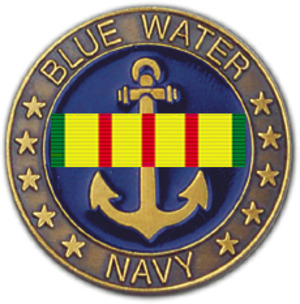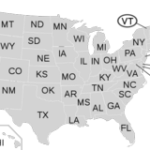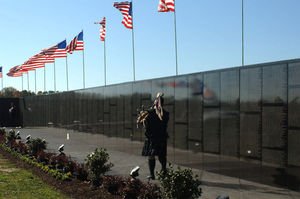I recently had the chance to speak with John Rossie of the Blue Water Navy Vietnam Veterans Association. Despite your political party, it is always a shame when a Veteran has to fight for benefits that he or she earned. Below is a recap of my conversation with Mr. Rossie earlier in August.
A bit of background: The Blue Water Navy Vietnam Veterans Association (also registered as The Blue Water Navy Association – BWNA) was birthed in 2004. This group of individuals came to be known as the Blue Water Navy (BWN). The purpose of the group is to bring attention to a great injustice. All Vietnam Veterans of the Vietnam War receive health and medical benefits for exposure to Agent Orange. That is all Veterans expect those who served offshore.
Initially, the organization started out as a discussion board group in response to the Department of Veterans Affairs’ (DVA or VA’s) February, 2002 unauthorized changes to a Federal law. Vietnam War veterans who had served in the waters offshore Vietnam were eliminated from eligibility for some benefits, most importantly medical and financial benefits for treatment of the various diseases recognized by the VA as having been caused by exposure to Agent Orange during military service in Vietnam,” said John Rossie, Executive Director of the Blue Water Navy Vietnam Veterans’ Association. “The normal procedure to overturn a law typically would involve placing a Notice of Proposed Rulemaking in the Federal Register and allowing time for public review and comments on the proposed change. The VA did not do this. The change resulted in loss of benefits for personnel who served offshore Vietnam between 1962 and 1975.”
The members of the chat group were Navy, Coast Guard and Marine veterans, and their wives, who had lost their federal benefits for Health Care coverage from the VA due to this change. In early 2006, John Rossie contacted the Institute of Medicine regarding some statistics referred to by the group regarding the high number of dioxin disabilities found within Navy personnel. John Rossie launched the Blue Water Navy website in February, 2006, and posted his own information along with the documentation supporting “boots on the ground” military members were not the only Veterans exposed to Agent Orange.
Around this time there was a case before the Veteran’s Board of Appeals that was under appeal to the Court of Appeals for Veterans Claims (CAVC) by retired Navy Commander Jonathon Haas, represented by the National Veterans Legal Services Program (NVLSP). CDR Haas had several of the diseases already acknowledged by the VA to be caused by exposure to dioxins contained in the defoliant Agent Orange. Haas had been denied benefits and was challenging the illegal change made by the VA in February, 2002,” continued Rossie.
The distinction of Blue Water referenced the ships that had been built for deep ocean travel between continents. Blue Water ships were built to survive the perils of the open seas. This is in distinction with brown water boats that were built specifically to travel within the shallow rivers and canals in the interior of Vietnam. Brown water boats were small, fast and maneuverable in very shallow water, but could not expect to survive an ocean crossing. The Blue Water Navy would consider a “boat” to be something that could be lifted aboard a ship.
When the VA changed its internal rules for awarding benefits to Vietnam Veterans, they went one step further, to add insult to injury. They changed their definition of “Vietnam War Veteran” to include ONLY those veterans whose feet actually touched the soil of Vietnam. All veterans including the Navy, Coast Guard and Marines who were on ships were suddenly re-classified as “non-Vietnam veterans” for the purposes of coverage under the Agent Orange Act of 1991. That 1991 legislation provided all Vietnam veterans with full VA benefits, including health care and lost wage compensation for diseases and disabilities caused by the dioxin in Agent Orange and other chemical defoliants used to clear trees and jungle vegetation to limit places where the enemy soldiers could hide.
Under the Agent Orange Act of 1991, all veterans who had been awarded the Vietnam Service Medal for having been in the Combat Zone of Vietnam were eligible for treatment for their service-connected medical problems resulting from exposure to dioxin-based herbicides at any VA hospital in the country. After the change in February, 2002, Blue Water Navy veterans were denied service-connected hospital treatment for any disease or disability caused by their exposure to Agent Orange (dioxin) during their time spent in the Combat Zone of Vietnam.
One special feature of the Agent Orange Act of 1991 was the introduction of the “presumption of exposure to herbicides in Vietnam.” Because there was no way to tell who had been exposed to the many herbicides used in Vietnam to kill various vegetation, all of which were harmful to humans, the Congress agreed that the veterans had no chance of proving direct exposure because the records and military documentation did not exist to act as such evidence, it was concluded that all veterans who operated within the Combat Zone of the Vietnam War were automatically presumed to have been exposed. The most widely used of the herbicides was Agent Orange, a combination of two defoliants that both contained dioxin, and it was generally dioxin poisoning that was causing the diseases and disabilities of the Vietnam War veterans.
“The DVA was tasked with writing up the rules as to how to identify and compensate injuries based on dioxin poisoning and they chose to identify eligible veterans by the receipt of the Vietnam Service Medal (VSM), awarded to anyone who entered the Combat Zone. Since the Combat Zone (or Theater of Combat) extended for a ways offshore, this clearly indicated that the DVA felt the Blue Water Navy was susceptible to contamination by dioxin,” said Rossie. This was backed by scientific studies and medical research showing that Navy personnel had higher rates of several of the dioxin-induced cancers than those who served on the ground. This included Non-Hodgkins Lymphoma, lung cancer, melanoma, mesothelioma, diseases the circulatory system and testicular cancer.
This rule regarding eligibility by receipt of the VSM stood until the change in 2002, when the VSM was suddenly eliminated as a primary factor. The DVA reported that they felt a large number of individuals who had not actually participated in the War activities had been awarded the VSM. By their change in definition, only veterans who had their “boots-on-ground” on the soil of Vietnam are now considered “Vietnam War veterans”. All others, specifically Blue Water Navy personnel who served offshore Vietnam, including those having been within Vietnam’s ports and harbors, where they may have anchored but not gone ashore, are now called “non-Vietnam War veterans” or “Vietnam Era veterans,” even though they may have spent a year or more of their tour of duty within 100 yards of the coastline providing Naval Gun Fire Support (NGFS) for those with “boots on ground” who desperately need artillery support to save them from being over-run by enemy forces, which is what the Blue Water Navy does during times of war.
“The DVA never gave a specific reason why this change was made. However, when Dr. Mark Brown, Ph.D., then Director of DVA’s Environmental Agents Services, made a presentation to the fourth program on “Science for Judges,” held at Brooklyn Law School on November 4, 2004, he very clearly stated the Department’s thoughts behind the elimination of a specific class of Vietnam veterans from presumptive coverage for herbicide exposure,” explained Rossie.
However, this “general policy” was nothing new. It was the requirement for proving “direct exposure” to Agent Orange and already known to be impossible to prove. To “provide evidence” required military documentation that Congress already recognized as difficult or impossible to find because very poor records were kept, no measurements of the toxicity of dioxin concentration in any area in or around Vietnam was ever made, and many records were lost or destroyed during or after the war. Regardless, the Blue Water Navy veterans “must show on a factual basis that they were exposed to herbicides during military service” in order to qualify for service-connected disability caused by dioxin. It was already known that this documentation did not exist for Vietnam War veterans at least in 1990, when Congress prepared to pass the Agent Orange Act of 1991, because that law was written to give every veteran (those who served on land and at sea) the “presumption of exposure.” Just by ‘being in Vietnam,’ which at that point in time included the entire Theater of Combat including offshore Vietnam, was enough to make every Vietnam War veteran eligible for medical and compensation benefits because it was acknowledged that it would be impossible for every veteran to find “official military documentation” to prove their exposure to herbicides. It just couldn’t be done through no fault of the disabled and dying veteran.
That “presumption of exposure” is still given to every Vietnam War veteran except members of the Blue Water Navy (BWN). Every other veteran need only show that “they were there” at any location on the landmass of Vietnam, whether or not any military documentation exists to indicate exposure to Agent Orange actually occurred. If they have a medical condition on the VA’s list, their eligibility for full VA benefits is automatically presumed, as was true for the Blue Water Navy between February, 1991(when Public Law 102.4 was passed) and February, 2002 (when the definition of a “Vietnam War veteran” was changed to exclude the Blue Water Navy.)
On August 16, 2006, The Court of Appeals for Veteran Claims ruled in favor of Jonathon Haas and granted him full benefits for his Agent Orange disabilities. The Haas ruling supported the argument that, if one had been awarded the Vietnam Service Medal because of their presence within the designated “Combat Zone,” then they were “in” the Republic of Vietnam for purposes of the “presumption of exposure to herbicide” just as they were “in” the Republic of Vietnam facing the threat of enemy gunfire.
This ruling infuriated the Headquarters of the DVA. On September 9, they ordered their 56 Regional Offices to stop processing any Blue Water Navy claim for Agent Orange illnesses. Done without the sanction of the Court, this was blatantly illegal. The DVA also appealed the overturned ruling to the U.S. Court of Appeals for the Federal Circuit, a Court entirely outside the VA System of Law.
On January 9, 2007, the CAVC ordered the Board of Appeals for Veteran Claims to once again process all Blue Water Navy claims. But at the same time, the Court suggested to the Department of Veterans Affairs a path to follow in properly filing a request to approve the VA moratorium on BWN claims processing which the court would “consider” upon submission by the DVA. Within the week, the VA filed a request exactly to the specifications of the CAVC requesting permission to “stay” all Blue Water Navy claims until a final ruling was given on the Haas Case, which had been appealed to the Court of Appeals for the Federal Circuit. On April 13, 2007, the CAVC ruled to enforce the VA’s moratorium on processing BWN claims and further ruled that the actions of the DVA to stop processing BWN claims was retroactively legal back to September 9, 2006.
In May, 2007, the DVA filed a brief with The Court of Appeals for the Federal Circuit. That Court finally overturned the ruling of the CAVC, as per the DVA’s wishes, on May 9, 2008. One of the few cogent arguments stated by the DVA as justification for excluding the BWN from the Agent Orange Act of 1991 was that since the Agent Orange was only sprayed on the land and never over the water, they had no idea how any of that substance could have gotten into the water, or traveled through the air, and cause problems for the Blue Water Navy. Not only was there “official military documentation” that some Agent Orange was actually sprayed on the coastal waters and several payloads of Agent Orange had been jettisoned into the coastal waters for emergency reasons, but the argument failed to take into account the Water Cycle of our planet, wherein the rains wash into the streams to rivers which empty into the bays, ports and harbors or directly out into the offshore waters of the sea.
During these several years of the Haas Case, the Documentation Library on the Blue Water Navy Association Web site was cited in briefs and other documents filed with the various courts. Today that documentation list continues to grow as more research is published associating dioxin with other diseases and as more information is found about the illegal disposal of Agent Orange and the other “rainbow herbicides” that were sent to military bases around the world for improper disposal. This Library will soon begin collecting evidence needed by Gulf War and later veterans regarding the many diseases they are coming home with that the DVA fails to consider as service-connected disease and disability,” said Rossie. Despite the rhetoric about this country and its leaders supporting the veteran, the cycle of the need to ‘fight the system’ for earned and promised benefits is not being faced by the offspring of the Vietnam Veterans.
John Rossie continues to help provide information and assistance to Veterans. More information, and documentation, on this and related issues can be found at: http://bluewaternavy.org/







